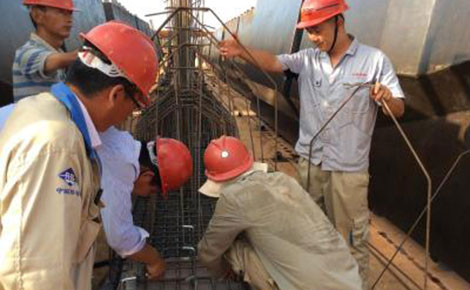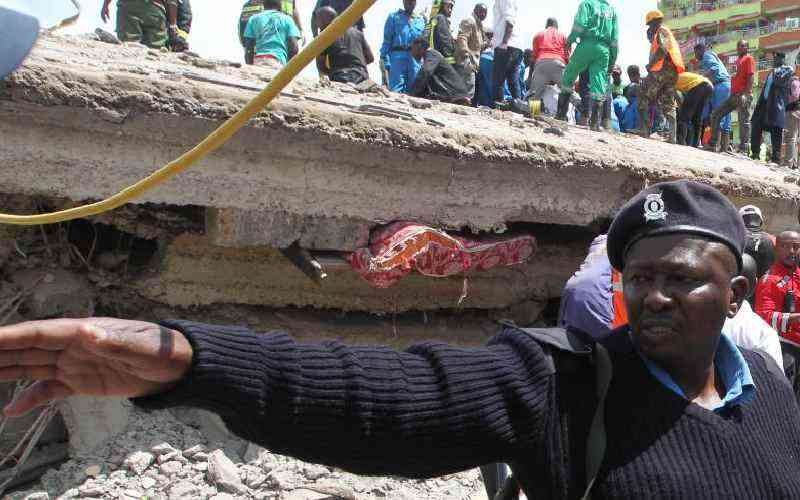 |
|
Chinese Standard Gauge Railway workers put together one of the tens of bridges to be built during the construction of the 327billion project at Kathekani camp.The media went on a tour of Mariakani,Voi and Kathekani camps were they witnessed heavy mobilization and construction. [PHOTO:courtesY] |
The Government is rushing to pay the remaining landowners ahead of the deadline, before construction of the Mombasa-Nairobi Standard Gauge Railway (SGR) begins in the New Year.
Kenya Railways Corporation (KRC), the project’s implementing agency says Sh4.9 billion has been released to compensate persons affected by the project
They are currently making payments to people whose land has been acquired along the railway corridor. The Government expects to pay Sh10 billion to the land owners affected by the railway line.
Project Manager Maxwell Mengich said on Monday during a tour of various project sites including Mariakani in Mombasa County, and Kathakani (Machakos) that preparations are in top gear and project will begin after the New Year.
Land acquisition
Eng Mengich noted that 85 per cent of the land acquisition is done, and the process is expected to be completed by February. “The process is set to progress well because we are finalising land acquisition. We have already acquired the land from Mariakani to Athi River and the corridor is now available for the construction works. Real works is set to start at the beginning of the year,” he said.
The construction works are being handled by China Road and Bridge Corporation. It is expected to take 42 months with most of the initial preparation works being is complete.
Currently, excavation for construction materials and various earthworks are ongoing as well as ballast production, sleeper precasting production. Various tests being carried out including cement quality test, soil densities and dynamic penetrations, reinforcement steel yield stress and quality tests among others. Twenty one camps have already been constructed with facilities such as living quarters, laboratories, administrative offices, mixing and crashing plants among other facilities. The project has been divided in eight sections. The railway track will be assembled at section six and taken to the construction site in panels.
Along the Mombasa-Nairobi route, there will be 33 crossing stations and two passenger and freight handling stations in Mombasa and Nairobi. “To make sure that we do not endanger our wildlife, we have identified eight corridors where we will build bridges to provide underpasses which will be 70 metres high and 50 metres wide to make animals move with ease,” said Mengich.
Unlike the old railway, Mengich says the SGR will be protected against being swept away by flash floods through protective works on embankments and quality control. The SGR will be 10 metres apart from the old Meter Gauge Railway from Mombasa to Nairobi. However, the SGR will be fairly straight.
The trains will be diesel powered initially but the construction will have electricity lines as a provision for future electrification. The gauge will also be seamless, unlike the current metre gauges which are different even within the Kenyan railway network, making it impossible to have one train make a non-stop journey.
Current capacity
The new standard gauge rail will have a handling capacity of 216 20-foot equivalent units equivalent to 4,000 tonnes per train, which are over 10 times the current capacity of 20 equivalent units.
Once completed, the project is expected to reduce the transport costs, increase economic activity, enhance regional integration and provide both direct and indirect employment. “The project is not for the Kenyan President. It will benefit every Kenyan,” said David Chen, Section Two liaison manager. “So far, they have 5,377 Kenyans and 1,000 Chinese workers. At its peak, we expect the project to provide 30,000 jobs. If all goes well, we expect the construction of phase one to be complete by July 2017,” said Mengich.
Some of the land owners say even though they have been compensated, relocating their business has been an inconvenience. “Some of us thought that we would be chased away without any compensation but we appreciate that we have been compensated. However, we have been taken aback because now we have to start from scratch and set up our business elsewhere,” Tabitha Njue, 48. She had built rental houses along the corridors.
Stay informed. Subscribe to our newsletter
However, some of the beneficiaries in the compensation of the SGR project have complained of receiving less money. They blame the Government for undervaluing their properties resulting to huge losses. “I am not happy at all with the compensation because I have gone at a loss. I have to start from zero and look for another land to build and acquiring land at time is very expensive,” said Nathan Mwojombo who had to give up his a acre plot at Ndii.
“I’m sad to leave my home that I build from scratch. It pains to know that it will come crashing down. Even though I have been paid, I cannot be able to acquire the seven acres I had because land is expensive right now and the compensation wont’ be enough for that much including building a new home,” said Patricia Mwanzia, a mother of four.
Mengich acknowledged that they have received some complaints but the ministry is in the process of settling them before the construction kicks off.
 The Standard Group Plc is a
multi-media organization with investments in media platforms spanning newspaper
print operations, television, radio broadcasting, digital and online services. The
Standard Group is recognized as a leading multi-media house in Kenya with a key
influence in matters of national and international interest.
The Standard Group Plc is a
multi-media organization with investments in media platforms spanning newspaper
print operations, television, radio broadcasting, digital and online services. The
Standard Group is recognized as a leading multi-media house in Kenya with a key
influence in matters of national and international interest.
 The Standard Group Plc is a
multi-media organization with investments in media platforms spanning newspaper
print operations, television, radio broadcasting, digital and online services. The
Standard Group is recognized as a leading multi-media house in Kenya with a key
influence in matters of national and international interest.
The Standard Group Plc is a
multi-media organization with investments in media platforms spanning newspaper
print operations, television, radio broadcasting, digital and online services. The
Standard Group is recognized as a leading multi-media house in Kenya with a key
influence in matters of national and international interest.









